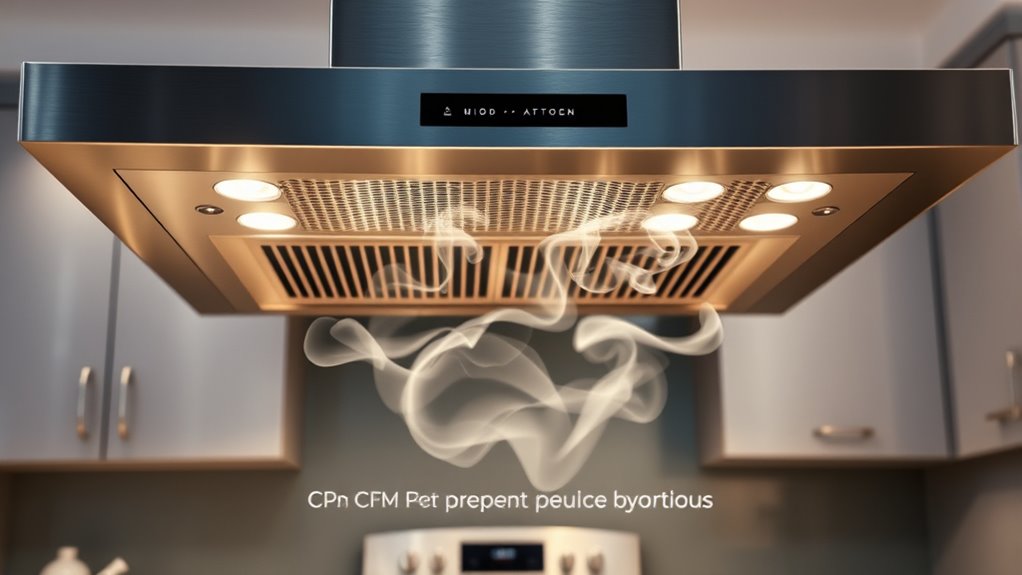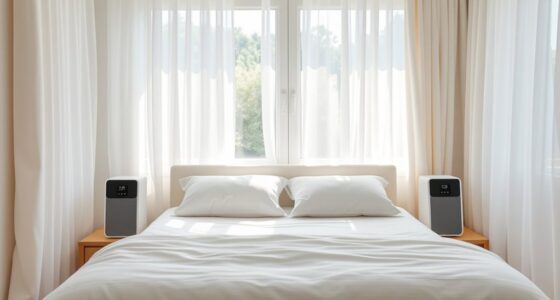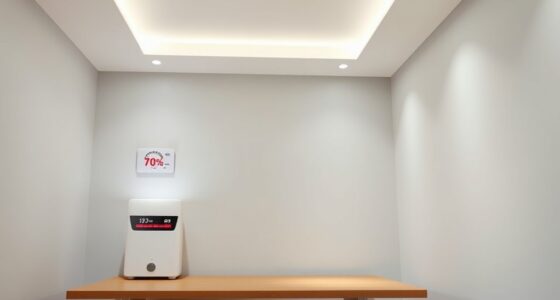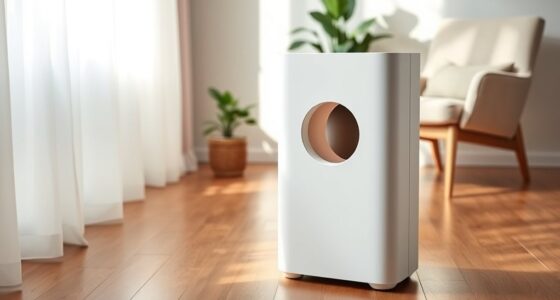To get smoke out without causing backdrafts, you need to accurately determine your range hood’s CFM. Measure your cooktop’s width in feet, then multiply by a standard height of about 3 feet to find the cubic footage. Multiply that by 0.33—recommended air changes per minute—to get the ideal CFM, usually between 300-600 for residential kitchens. Proper duct sizing and hood design are also key. Keep exploring to find out how to fine-tune your setup effectively.
Key Takeaways
- Measure your cooktop’s width in feet and multiply by 3 feet height to get cubic footage.
- Use recommended air changes per minute (0.25–0.33) to calculate needed CFM.
- For typical kitchens, select a range hood with 300–600 CFM based on cooking intensity.
- Ensure ductwork is properly sized and smooth to minimize resistance and maximize airflow.
- Consider hood design and duct length to prevent backdrafts and ensure efficient smoke removal.

Understanding how to calculate the right CFM (cubic feet per minute) for your range hood is crucial to guarantee proper ventilation in your kitchen. When you select a range hood with the appropriate CFM, you improve ventilation efficiency, effectively removing smoke, steam, and cooking odors. But achieving this isn’t just about picking a high-powered fan; it’s about understanding airflow dynamics and how they influence your kitchen’s environment. Proper airflow ensures that the air moves smoothly, preventing backdrafts and ensuring contaminants don’t linger.
To start, you need to contemplate the size of your cooking area. Measure your cooktop’s width in feet and multiply that by a standard height of about 3 feet, which is roughly the height of your range. For example, if your cooktop is 30 inches wide (2.5 feet), your calculation begins with 2.5 x 3 = 7.5 cubic feet. Next, you need to determine how many times you want the air to be replaced per minute. For typical residential kitchens, a ventilation rate of 15 to 20 air changes per hour is recommended by experts. Divide this number by 60 to convert it into air changes per minute, which results in 0.25 to 0.33. Then, multiply your cubic footage by this rate to find the necessary CFM. Using the previous example, 7.5 x 0.33 gives roughly 2.5 CFM, but this seems low because it doesn’t account for factors like the type of cooking or the kitchen’s layout.
In reality, you should aim for a higher CFM to ensure effective removal of smoke and odors, especially if you do a lot of high-heat cooking or frying. For most home kitchens, a range hood with 300-600 CFM provides a good balance of ventilation efficiency and airflow dynamics, preventing backdrafts and ensuring contaminants are swiftly moved out. Keep in mind, the hood’s design and ductwork also influence airflow; smooth, properly sized ducts minimize resistance, optimizing performance. Too narrow or long duct runs reduce airflow and decrease ventilation efficiency, leading to smoky backdrafts or lingering smells.
Frequently Asked Questions
How Do I Measure My Kitchen’s Volume Accurately?
To measure your kitchen’s volume accurately, start by measuring its length, width, and height in feet. Use a tape measure to get precise readings, then multiply these dimensions to find the total cubic footage. Consider your cooking habits and kitchen layout, as they influence ventilation needs. Knowing your kitchen’s volume helps you select the right range hood CFM, ensuring effective smoke removal without backdrafts.
What Factors Influence the Ideal Range Hood Size?
The ideal range hood size depends on your kitchen’s ventilation standards and duct design. You should select a hood with at least 100 CFM for every 10,000 BTUs of your stove’s output. Proper duct design guarantees efficient airflow and prevents backdrafts. Consider the hood’s width relative to your stove, ensuring it covers the entire cooking surface for effective smoke and odor removal. Proper sizing keeps your kitchen safe and odor-free.
Can a Higher CFM Cause Excess Noise?
Yes, a higher CFM can cause excess noise. When your range hood’s fan runs at a higher speed, it generates more noise levels and vibrations. You might notice increased humming or rattling sounds, especially if the fan isn’t well-installed or if parts aren’t secure. To minimize this, choose a model with noise-reduction features and confirm proper installation, so fan vibrations don’t amplify the noise.
How Often Should I Replace or Clean My Range Hood Filter?
You should clean your range hood filter every 1 to 3 months, depending on how often you cook and the type of filter. Replace the filter if it’s damaged or excessively greasy, usually once a year or as recommended by the manufacturer. Regular filter maintenance helps your hood operate efficiently, prevents odors, and guarantees good air quality. Keep an eye on buildup and replace or clean accordingly for ideal performance.
Is There a Way to Improve Airflow Efficiency Without Increasing CFM?
You can boost airflow efficiency without upping CFM by sealing leaks around your range hood and ensuring proper ducting. Regularly cleaning filters and vents also help airflow optimization, preventing blockages that hinder performance. Think of it as squeezing water through a hose—you want a smooth flow. These efficiency improvements make your range hood work smarter, not harder, keeping smoke out while conserving energy and reducing noise.
Conclusion
Now that you’ve cracked the range hood CFM math, you’re ready to banish smoke like a kitchen superhero. Just remember, choosing the right airflow isn’t unlike wielding Thor’s hammer—powerful yet precise. With your newfound knowledge, you can keep your kitchen fresh and backdraft-free, making every meal a celebration rather than a smoky saga. So go ahead, channel your inner hero, and let your range hood do the heavy lifting—your culinary kingdom deserves it.









